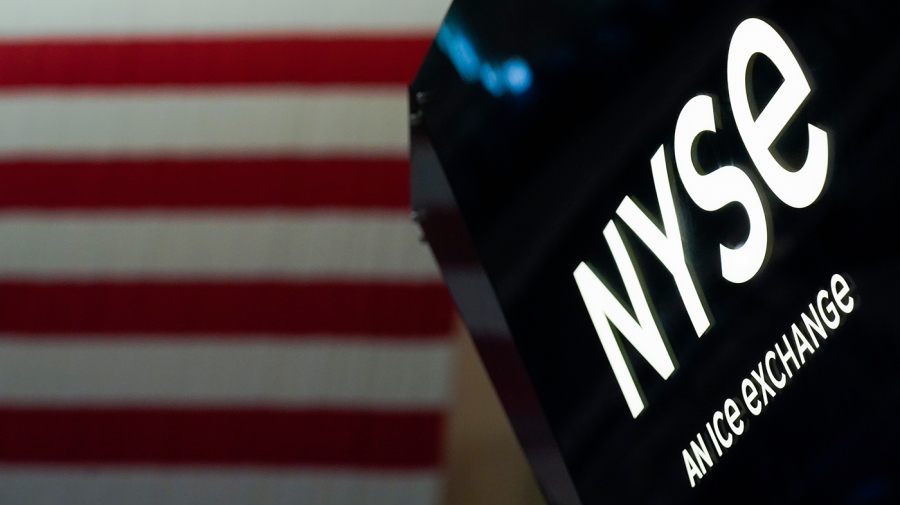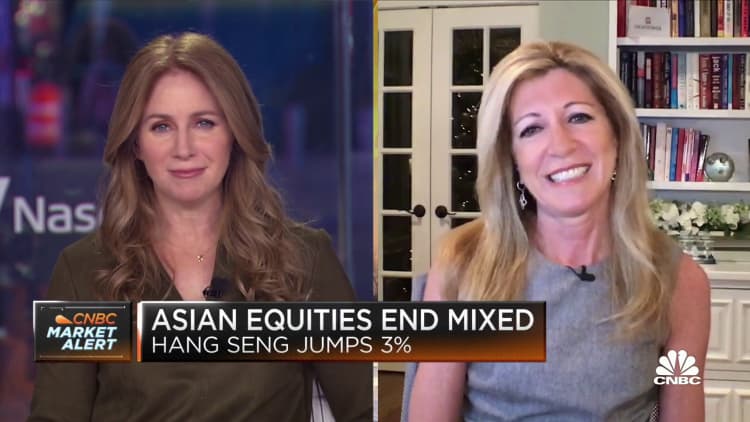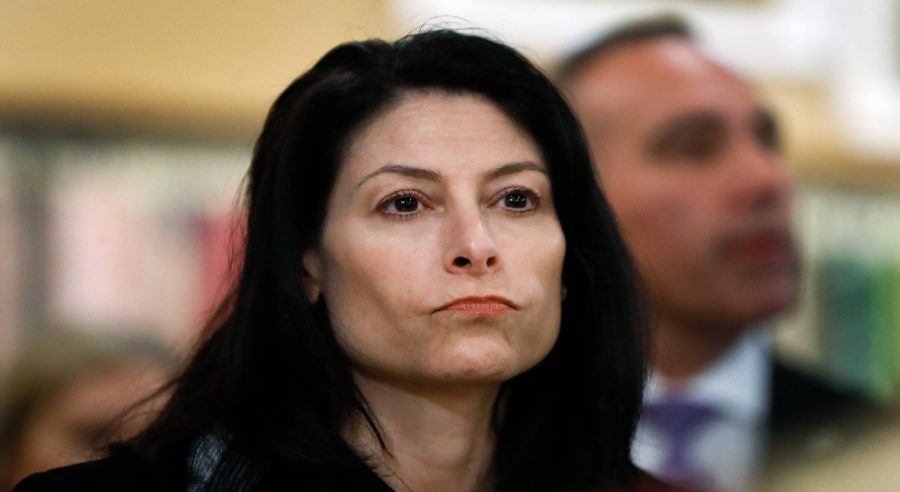Bond prices surge, yields fall as economic data signals cooling inflation
Bond prices rallied with stocks, sending yields down, after two key economic reports signaled inflation my be cooling off as the Fed raises interest rates.
The yield on the benchmark 10-year Treasury was down by 16.2 basis points at 3.56%. The 2-year Treasury yield fell 18.9 basis points to 4.264%. The yield on the 30-year Treasury was down 11.8 basis points at 3.68%.
Yields and prices move in opposite directions. One basis point equals 0.01%.
—Carmen Reinicke
Stocks making the biggest moves midday
Check out the companies making headlines in midday trading.
- World Wrestling Entertainment — The wrestling entertainment stock surged 21% after WWE announced that founder Vince McMahon is returning to its board of directors and that the company is exploring strategic moves. McMahon stepped down as CEO last year after an investigation into sexual misconduct, but has remained majority shareholder. The Wall Street Journal reported that McMahon is returning to pursue a potential sale of the business.
- R1 RCM — Shares of the healthcare technology firm soared more than 11% after the company raised its revenue outlook for 2023. The company also reaffirmed its projection for full-year 2022.
- Costco Wholesale — Shares of the big-box retailer jumped more than 6% after it reported solid sales numbers for December. Costco posted net sales of $23.8 billion in December 2022, marking an increase of 7% year-over-year. Evercore ISI also added Costco to its “fab five” list, saying it’s a defensive stalwart.
— Sarah Min
First week of year signals volatility ahead for stocks, Goldman Sachs says
Investors may not want to get too excited about Friday’s rally.
“This first week of 2023 (and January) has come with the usual raft of major economic data points which on net point to the unusual post-pandemic era combination of a resilient labor market set against eroding business sentiment across the economy,” analysts at Goldman Sachs wrote in a Friday note. “Even as Corporate America continues to hire over 200,000 net new workers a month and post over 10mn job openings, both the Manufacturing and Service sector feels like things are getting worse.”
Of course, things getting worse is relative to one of the best GDP expansions the U.S. has seen, according to the note. This was partially fueled by pandemic stimulus through 2021.
“But this unusual combination we are now seeing of slow growth, high inflation, and elevated stock market valuations is likely to make for an uneven trading landscape in the year ahead,” Goldman said. That’s likely to mean modest returns for stocks this year.
—Carmen Reinicke
Tesla reverses slump, trades higher
Tesla reversed a more than 5% slump Friday following news that the electric vehicle maker would lower prices on some models of cars in China.
Later in the day, however, Tesla rose with the broader market. It was up 1.85% at midday.
Fed’s Barkin says rate hikes can be done ‘more deliberately’ now
Richmond Federal Reserve President Thomas Barkin said Friday the central bank has to keep working to bring down inflation but can do so with a little less intensity.
“We still have work to do,” the central bank official said in prepared remarks. “Inflation is too high, and we will need to stay on the case until it is sustainably back to our 2% target. We have forecasted additional rate increases this year.”
Policymakers indicated in December that they’re likely to take rates up another percentage point or so before pausing. Atlanta Fed President Raphael Bostic earlier in the day told CNBC he expects the central bank’s benchmark funds rate rising past 5%, from its current 4.25%-4.5% target range.
Barking did not specify how high he thinks the rate should go. However, he said the Fed now can move “more deliberately” after raising rates aggressively seven times in 2022.
—Jeff Cox
Health care, hospitality lead December job gains
Health care and social services was the top category for job growth in December, followed by leisure and hospitality, as the U.S. labor market continues to show strength despite the Federal Reserve’s aggressive rate hikes.
Meanwhile, two sectors that had been struggling in recent months — retail and transportation and warehousing — snapped back to growth in December.
Bank of America downgrades Chevron as oil prices cool
As oil prices cool, Bank of America is expecting Chevron won’t outperform as much as it did in 2022.
The firm expects a modest 9% upside after gaining more than 50% in share value last year. Analyst Doug Leggate also downgraded the stock to neutral from buy, citing limited upside as oil prices stabilize following the jump prompted by Russia’s invasion of Ukraine.
“Put simply we see CVX as a victim of its own success – but with <10% upside to our estimate of fair value, we believe the appropriate rating vs North American peers is Neutral,” Leggate said in a note to clients Friday.
CNBC Pro subscribers can read more about Leggate’s call here.
— Alex Harring
Goldman’s Hatzius says jobs numbers consistent with ‘soft landing’
December’s employment report helps add to the narrative that the U.S. may be able to avoid a recession, Goldman Sachs chief economist Jan Hatzius said Friday.
“We’re growing at a below-trend pace that’s necessary to rebalance the economy. Wage growth is gradually decelerating, price inflation is pretty quickly decelerating,” Hatzius said on CNBC’s “Squawk of the Street.” “I think that should be encouraging for a soft landing.”
He spoke after the Labor Department reported a 223,000 increase in nonfarm payrolls and a 4.6% annual rise in average hourly earnings, the slowest pace for the latter metric since August 2021.
—Jeff Cox
Wells Fargo upgrades Lululemon
Wells Fargo analyst Ike Boruchow upgraded shares of Lululemon to overweight, calling the athletics apparel retailer a “rare name with momentum.”
“LULU’s top-line resilience in the past few years has been nothing short of stunning, with 2022E’s topline expected to be essentially double 2019 levels,” he said, expecting continued resilience in 2023.
CNBC Pro subscribers can read the full story here.
— Samantha Subin
Stocks typically rebound massively following big yearly losses
History shows that the stock market typically rebounds drastically following a year of big losses, according to S&P Dow Jones Indices.
Since 1936, of the nine prior years with double-digit losses, seven of those years experienced double-digit gains the following year (an average of 18%), according to the firm. The S&P 500 lost 19.4% in 2022, suffering its worst year since 2008.
Stocks rally on slower wage growth but are ignoring other message in jobs data
The December jobs report shows the economy is still adding jobs at a strong rate, but investors focused on the fact that wage growth is slowing, suggesting inflation may be ebbing.
Stocks rallied after the 8:30 a.m. ET employment report showed 223,000 jobs were created in December. Average hourly wages grew at an annual pace of 4.6%, less than the 5% expected by economists.
“The big move was the fact that average hourly earnings came in lower than expected. That suggests that investors are focused intently on inflation, and whether that inflation is moving toward the Fed’s target,” said Michael Arone, chief investment strategist at State Street Global Advisors.
But he also cautioned that the data could be double-edged, since it suggests the economy and employment are still strong. That could help keep inflation elevated and keep the Fed hiking more than markets might expect.
The Fed next meets Jan. 31 and Feb. 1. While some economists anticipate a half point hike after that meeting, traders in the futures market put greater odds on a smaller, 25 basis point hike. A basis point equals 0.01 of a percentage point.
“Data like today suggests the Fed could do 50 basis points,” said Arone. A more aggressive Fed could create more market volatility.
The Fed has been trying to slow the economy and the hot labor market through its rate hiking, which has taken the fed funds target rate range to 4.25% to 4.50%.
Peter Boockvar, chief investment officer at Bleakley Financial Group said market expectations did not change after the jobs report, and the fed funds futures contract for February was pricing in another 32 basis points of hikes.
“It’s pricing 100% chance of a 25 basis point hike, and a 30% chance for an additional 25. Peak fed funds is still at 5%” for July, he said. “The market is still expecting the Fed to go another 60, almost 70 basis points,” he said. Boockvar said the end point for the Fed matters more than if it raises by 25 basis points or 50 when it next meets.
–Patti Domm
KeyBanc says Bed Bath & Beyond shares can fall to 10 cents amid bankruptcy warning
KeyBanc is expecting shares of Bed Bath & Beyond to fall to 10 cents as the beaten down retailer warns it could seek bankruptcy protection.
Analyst Bradley Thomas reiterated his underweight rating on shares, while slashing his price target to 10 cents from $2. That implies 94% downside from Thursday’s close.
Read more on the call from KeyBanc here.
— Samantha Subin
Services sector contracted in December, ISM survey shows
The services sector contracted in December amid a pullback in new orders and production, the Institute for Supply Management reported Friday.
The ISM Services index fell to 49.6% for the month, well below the Dow Jones estimate for a 55.1% reading. The gauge measures the percentage of businesses reporting expansion, with a reading below 50% indicating contraction.
New orders fell 10.8 percentage point while business activity and production dropped 10 points. Prices fell 2.4 points to 67.6%, still a high number but representative of some softening in inflation. Employment also fell, moving down 1.7 points to 49.8% and into contraction territory.
—Jeff Cox
Morgan Stanley says banks’ 4Q results hit by higher loan loss reserves and expenses
Jane Fraser speaks during the Milken Institute Global Conference in Beverly Hills, California, U.S., on Monday, April 29, 2019.
Kyle Grillot | Bloomberg via Getty Images
Banks reporting fourth-quarter results next week will miss earnings estimates because they’ll need to plow money into loan loss reserves ahead of an expected downturn, according to Morgan Stanley analysts led by Betsy Graseck.
The companies will likely “incorporate a more severe economic outlook” into their scenarios for loan defaults this year, forcing them to set aside more than expected in reserves, Graseck wrote in a note published Friday.
On top of that, banks are likely to disclose bigger-than-expected increases to 2023 expense guidance because of wage inflation, Graseck wrote. She expects the median big bank to guide to about 4% expense growth, above the consensus of 3%.
Her pessimistic view on banks is shared by Deutsche Bank analyst Matt O’Connor, who cut his recommendation on Bank of America and JPMorgan Chase shares to hold from buy on Friday.
For her part, Graseck cut her price targets for Goldman Sachs and Citigroup shares by 7.3% and 8.9% respectively, thanks in part to her thesis.
On the other hand, she favors Wells Fargo, JPMorgan and Northern Trust heading into earnings because each bank could surprise to the upside on revenue and expenses, Graseck wrote.
—Hugh Son
Tesla falls to fresh 2-year low
Tesla shares reached their lowest level in about two years Friday after the electric car maker cut its Model 3 and Model Y vehicles. The stock traded 5.6% lower, dragging down the Nasdaq Composite.
Jobs report boosted expectations for soft landing, but recession clock is ticking, Shah says
Investors cheered Friday’s jobs report as signaling that a soft landing – a scenario in which the Federal Reserve tames inflation but doesn’t push the economy into a recession – is more likely.
“A lower unemployment rate and weaker average hourly earnings growth is certainly going to get equity market bulls’ attention,” Seema Shah, chief global strategist at Principal Asset Management said in a Friday note. “Indeed, expectations for a soft landing in the economy have likely been boosted in light of today’s jobs report.”
Still, investors may not want to cheer the news too much as it likely won’t change the Fed’s actions in the coming months.
“Yet, with the unemployment rate back to the historic low of 3.5%, how realistic is it to expect wage growth to move meaningfully lower? The Fed will likely be skeptical,” she said. “And so, with the record low unemployment rate indicating that there is still so much work ahead of them, Fed policy rates are set to rise above 5% within just a few months and a hard landing looks to be the most likely outcome this year. The recession clock is ticking.”
—Carmen Reinicke
Stocks open higher after better than expected jobs report
U.S. stocks opened higher Friday after investors cheered the December jobs report, which showed the labor market remains resilient but that wages aren’t gaining as much as expected amid the Fed’s interest rate hikes to tame inflation.
The Dow Jones Industrial Average increased 255 points, or 0.77%. The S&P 500 gained 0.68%, while the Nasdaq Composite jumped 0.44%.
—Carmen Reinicke
Wages improve but jobs report keeps Fed on track to raise rates
Wage growth in December was less than the 5% annual pace expected by economists, but it should not influence the Federal Reserve’s rate hiking path when it meets in February.
Some economists expect the Fed will raise rates by a half percentage point, while traders in the futures market have been betting on a quarter point hike.
“This is steady as she goes for the Fed. There’s no reason to stop raising rates at this time,” said Diane Swonk, chief economist at KPMG. “They still have wages growing at 4.6%, which is above the 3% to 4% they think is necessary to bring inflation down to their 2% target. The trend is the right direction for the Fed. Average hours worked continued to tick down.”
The economy added 223,000 jobs in December, more than the 200,000 expected by economists. Average hourly wages increased 0.3% on a monthly basis.
“We’ve got 4.5 million new pay checks for the year. That’s the second strongest year on record,” said Swonk. She said 2022 was second to 2021, when there were 6.7 million jobs created. “The only thing close was 1946 when soldiers returned to civilian work after World War II.”
December jobs report should add investor confusion, market volatility
Investors are so far cheering the December jobs report, which showed wage gains may have moderated, signaling progress in the fight against high inflation. Still, it’s likely to lead to choppy markets.
“While the easing of wage pressures may initially be cheered by markets, workers are still not keeping up with inflation, therefore pressuring consumption trends,” said John Lynch, Chief Investment Officer for Comerica Wealth Management.
“This report should add to investor confusion and heighten market volatility in the weeks ahead,” he added. “It also complicates the Fed’s battle against inflation, though the minutes from the December monetary policy meeting reiterate the committee’s resolve.”
“A 50-basis point move is back on the table for the next FOMC meeting in a few weeks,” he said.
—Carmen Reinicke
U.S. economy adds more jobs than expected in December
The U.S. economy added 223,000 jobs last month, slightly more than a Dow Jones consensus forecast for a 200,000 gain. This is yet another sign that the economy remains strong even as the Federal Reserve tries to tame inflation through higher rates. However, wages grew at a slightly slower-than-expected pace, increasing 0.3% versus an estimate of 0.4%.
— Fred Imbert
Stocks making the biggest premarket moves
Southwest projects fourth-quarter loss after mass flight cancelations
Last month’s operational meltdown was a costly one for Southwest, the airline said Friday.
The airline released guidance for its fourth quarter results that projected a net loss for the period, due in part to charges of between $725 million and $825 million from flight cancelations. Between $400 million and $425 million was lost revenue from the flights, while the rest comes from reimbursements to customers, premium pay to employees and other factors.
Shares of Southwest were down 2.7% in premarket trading.
— Jesse Pound
Citi downgrades U.S. equities, saying valuations are expensive
Citi has cut its rating on U.S. equities to underweight heading into the new year, partially due to the dollar’s strength waning.
“We are no longer dollar bulls, which helped keep us Overweight in 2022,” Robert Buckland wrote in a Friday note. “Valuations remain expensive compared to elsewhere.”
He also noted that earnings expectations look too optimistic, especially given the 2023 recession that Citi economists are forecasting.
He also downgraded Japan, noting that it “remains a highly cyclical stock market and is vulnerable to an appreciation in the yen.”
—Carmen Reinicke
JPMorgan downgrades Silvergate Capital
JPMorgan downgraded crypto bank Silvergate Capital, citing concern around the company’s huge fourth-quarter withdrawals.
“While the challenging backdrop for the crypto settlement business was a factor in the worse than expected results being released, we also believe that concerns voiced by short-sellers (on Twitter) likely also contributed to Silvergate’s customers withdrawing deposits from the platform at a greater than anticipated level,” JPMorgan said. “The implications to the company’s business from the significant reduction in client deposits has near- as well as longer-term impacts,”
Shares fell more than 15% in the premarket after plunging more than 40% on Thursday.
— Sam Subin
Tesla shares fall after EV maker cuts China prices again
Tesla fell 5% in the premarket after the Elon Musk-led company lowered prices for its Model 3 and Model Y vehicles in China. The EV maker said the cars would now be priced at 229,900 yuan (about $33,374) and 259,900 yuan, respectively.
Reuters calculations show these prices are 13%-24% from four months ago. Tesla had lowered prices in October in an effort to prop up sales against rivals in China such as BYD.
— Fred Imbert, Jihye Lee
Deutsche Bank downgrades Bank of America and JPMorgan Chase
Deutsche Bank analyst Matt O’Connor downgraded Bank of America and JPMorgan Chase to hold from buy, citing a weakening macro outlook.
“In some ways, it’s tempting to get more positive given stocks are already down sharply, inflation seems to be slowing and Fed rate hikes may be coming to an end,” he said. “But our gut is that stocks will set new lows and fully (or close to it) price in a US recession suggesting there’s more risk from here.”
CNBC Pro subscribers can read more here.
— Sam Subin
European markets mixed ahead of key euro zone inflation data
European markets were cautious on Friday morning ahead of key inflation data for the euro zone, which is expected to show a further slowdown in consumer price increases.
The pan-European Stoxx 600 index hovered just above the flatline in early trade, with basic resources adding 1.2% while utilities fell 0.4%.
Flash euro zone consumer price index inflation figures are due late morning. After France, Germany and Italy all reported better-than-expected slowdowns over the course of the week, investors are hopeful that inflation has passed its peak across the 20-member common currency bloc.
WWE shares rise in extended trading
— Rebecca Picciotto, Sarah Min
Leon Cooperman says new bull market isn’t coming anytime soon
Billionaire investor Leon Cooperman said he’s still holding a cautious view on stocks and the economy, but he’s finding cheap stocks to buy after the recent correction.
“I would basically take the position that we’re in a market of stocks rather than a stock market,” Cooperman said on CNBC’s “Closing Bell Overtime” Thursday. “I think anybody looking for a new bull market anytime soon is looking the wrong way.”
CNBC Pro subscribers can read the full story here.
— Yun Li
Where the major averages stand this week
Stocks are set to close out the first trading week of the year with losses. As of Thursday’s close, here are where the major averages stand:
- The Dow Jones Industrial Average is down 0.66% week to date, on pace for its fourth negative week in five.
- The S&P is down 0.82% week to date, on pace for its fifth negative week in a row for the first time since its 7-week streak ending 5/20/2022.
- The NASDAQ is down 1.54% week to date, on pace for its fifth negative week in a row for the first time since its 7-week streak ending 5/20/2022.
— Chris Hayes, Sarah Min
Stock futures open higher
U.S. stock futures opened higher Thursday night after the major averages declined on the back of strong jobs data that could point to further rate hikes, and as investors looked ahead to the December jobs report Friday.
Dow Jones Industrial Average futures rose by 21 points, or 0.06%. S&P 500 and Nasdaq 100 futures climbed 0.13% and 0.19%, respectively.
— Sarah Min













